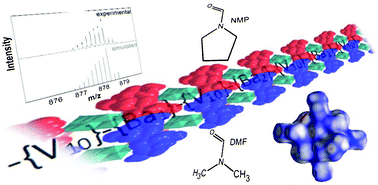A proof of principle study is reported which introduces a new synthetic route for the assembly of 1-dimensional barium-linked polyoxovanadate chains. Bulky coordinating solvents featuring a binding site and a blocking site are employed and allow the controlled linkage of decavanadate clusters, [V10O28]6−, by barium(II) centres. Using the bulky solvent N-methyl-2-pyrrolidone (NMP), it is shown that a complex supramolecular architecture, {[Ba(nmp)4(H2O)]2[H4V10O28]}{[Ba(nmp)3(H2O)2][H3V10O28]}2·2H2O·10 NMP}∞ (1) can be accessed where mono- and dinuclear barium units link decavanadate clusters into a linear chain. Using N,N-dimethyl formamide (DMF), a less complex architecture, [(Ba(dmf)4]2[H2V10O28] (2), is formed where only dinuclear barium(II) linkages are observed. Theoretical Hirshfeld-analysis of the crystal lattices is used to examine the ‘shielding’ effect of the bulky ligands. ESI-mass-spectrometric studies give insight into potential fragments formed in solutions of 1 and 2.
You have access to this article
 Please wait while we load your content...
Something went wrong. Try again?
Please wait while we load your content...
Something went wrong. Try again?


 Please wait while we load your content...
Please wait while we load your content...